The Chevrolets: From Flint to Fame to Fate
On this day in 1946, Arthur Chevrolet, an auto racer and the brother of Chevrolet auto namesake Louis Chevrolet, commits suicide in Slidell, Louisiana; he was 61.
A Swiss native like his older brother Louis, Arthur’s birth year has been variously listed as 1884 or 1886. By the early 1900s, Louis and Arthur, along with their younger, French-born brother Gaston, had left Europe and moved to America, where they became involved in auto racing. In 1905, Louis defeated Detroit’s racing legend Barney Oldfield at an event in New York.
Louis Chevrolet’s racing prowess eventually caught the attention of Flint’s William C. Durant, who in 1908, founded General Motors (GM). Operating from Durant’s original carriage works known as Durant-Dort Factory №1 at 303 West Water Street, Chevrolet began competing and designing cars for GM’s Buick racing team. In 1911, Chevrolet teamed up with Durant to produce the first Chevrolet car at the corner of Wilcox and Kearsley streets, a site that came to be known as “Chevy in the Hole.”
The two men clashed about what type of car they wanted, with Durant arguing for a low-cost vehicle to compete with Henry Ford’s Model T and Chevrolet pushing for something more high-end. In 1915, Chevrolet sold his interest in the company to Durant and the following year the Chevrolet Motor Company became part of General Motors.
While we are speaking of Flint, your humble scribe’s Uncle Bob Urich, a Navy combat officer of WW2, graduated from General Motors Institute in 1947. Referring to himself and his classmates as “Fifth Avenue Idiots,” Bob went on to direct time and motion studies at Flint’s Buicktown Plant. Stalking the factory floor with a stop-watch and clipboard, Bob earned the enmity of the rank-and-file. Decades later in 1998 when I was a younger attorney attending the UAW Constitutional Convention in Las Vegas, I mentioned this to one of the Flint delegates. The man wryly responded,“If you wanna get outta town alive, I’d keep that to yourself.”
Returning to the ill-fated Chevrolets, throughout their early era, Louis’ brothers continued racing and building cars. Arthur Chevrolet drove in the inaugural Indianapolis 500, held in 1911, though mechanical problems forced him out of the race and he failed to finish. He made another attempt at Indy 500 in 1916, but again did not finish. Baby-brother Gaston won the Indy 500 in 1920 in a Monroe-Frontenac designed by his brothers, only to die later that year in a racing accident at age 28. Hardship and tragedy would not relent.
Despite Louis and Arthur’s talents for racing and design (they also built aircraft engines), they had little gift for finance and were often pushed out of their endeavors before reaping the rewards due them. By the 1930s, both men were broke, and their racing careers over. Louis returned to Detroit to work in GM’s Chevrolet division; defeated, Arthur drifted down to Louisiana and “early retirement.” Louis died June 6, 1941, and Arthur hanged himself five years later.
If during this prolonged, difficult time in our national life, you or someone you love is experiencing extreme emotional challenges or thoughts of self-harm, please dial the National Suicide Prevention Lifeline at 988.
